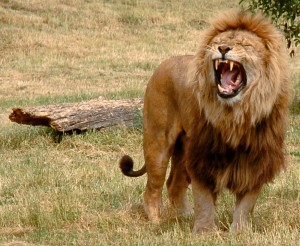Lions tend to hunt mostly by night or in the early mornings, and for much of the rest of the time are the embodiment of lassitude. However, being opportunists they'll hunt whenever the chance arises and that could be the middle of the hottest day.
Of some significance here is the fact that they’re not very fast animals, while by contrast, the animals they hunt are some of the fastest on the planet. A wildebeest can achieve a top speed of somewhere around 80 kph and maintain it effortlessly and even a humble wart hog can manage almost 50kph. In fact such is the disparity between predator and prey that many of the faster species don't even bother to run away at full speed, which must be galling to say the least.
 Consequently lions have developed two main hunting methods. The first is a version of grandmother's footsteps, in which the lion stalks from cover to cover with a final burst of speed at the end. (If spotted the lion will sit up and stare nonchalantly into the distance.) The second method is to find a bush close to something your prey needs - usually water - climb in and wait. This has the great advantage that the lion can catch up on sleep whilst technically "out hunting".
Consequently lions have developed two main hunting methods. The first is a version of grandmother's footsteps, in which the lion stalks from cover to cover with a final burst of speed at the end. (If spotted the lion will sit up and stare nonchalantly into the distance.) The second method is to find a bush close to something your prey needs - usually water - climb in and wait. This has the great advantage that the lion can catch up on sleep whilst technically "out hunting".Surprisingly, when hunting, lion don't seem to take account of wind direction. Researchers argue about this as it's impossible to judge an animal’s intention (if a lion walks towards an animal, is it hunting it, or was it just going that way anyway?), but when someone actually recorded wind direction in 100s of hunts that they observed, the lions hunted upwind (good idea) as often as they hunted down wind (...not such a good idea).
There are however two things that help the lion considerably. First they’re incredibly good at hiding and phenomenally patient. Secondly, the antelopes, while physically fast, are mentally not quite so sprightly and pay perhaps too little attention to learning from their mistakes.
George Schaller (who researched lion in the Serengeti and surrounding areas) recounts watching a group of Thomson's gazelles crossing a patch of thick bush in order to drink. When they entered the thick bush, it was bristling with lions that instantly grabbed and ate one of the gazelles. Over the next two hours the same group of gazelles, having apparently forgotten the recent murder of one of their companions, tried not once but twice more to get to the water using the same route…with predictable results.
In general however, memory loss aside, prey animals are most afraid of lion when they can't be seen. As a result, when a lion does appear they all stare at it - so long as they can see it, and it knows that they can see it, everybody's safe.
 Most antelope have very large bulgy eyes that are positioned on the sides of their heads. This gives them a very wide angle of view and makes them incredibly good at picking up movement. So for a lion, when it comes to surprising your prey, wind direction may be important, but it's not nearly as important as remaining out of sight.
Most antelope have very large bulgy eyes that are positioned on the sides of their heads. This gives them a very wide angle of view and makes them incredibly good at picking up movement. So for a lion, when it comes to surprising your prey, wind direction may be important, but it's not nearly as important as remaining out of sight.This comes in handy on a game drive looking for lions; any time you see gazelles, zebra and other prey animals standing with heads up and staring hard in one direction (assuming they’re not looking at you, which is very likely), there’s a good chance that they are keeping tabs on a predator such as a lion.
No comments:
Post a Comment